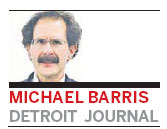A new start and a chance to cleanse debt
The story of Detroit - its spectacular rise as the US car capital, and now, unfortunately, its epic, historic slide into a bankruptcy filing, the largest ever in US history - fascinates Chinese automotive buffs, particularly the suppliers from China who have recently opened for business in the area.
Just ask John Yang, chief metallurgist with ZYNP International, the US distribution arm of Mengzhou-based ZYNP China Manufacturing, a maker of liners for automotive, heavy duty and agricultural engine cylinders. Detroit, Yang told China Daily last week, is no less than "the center of modern vehicle technology".
ZYNP's distribution center is located not in Detroit, but in the city of Romulus, about 40 kilometers southwest of the Motor City. ZYNP is among more than 100 Chinese companies, mostly in the automotive industry, that have set up shop mainly in the Detroit suburbs, driven to learn more about developing automobiles as part of a goal to become successful in the global marketplace.

You know things are bad in Motown when the Detroit Chinese Business Association, a nonprofit business network that fosters bilateral business relationships between US and Chinese companies, says its biggest challenge is battling "negative media publicity" about the city of Detroit's myriad urban problems, population plunge and estimated $18 billion debt load.
"Yeah, Detroit's got problems," said Milan Stevanovich, the association's executive director, "but Detroit is just one city. There's 168 of them in the Detroit metropolitan area. We've got seven major counties, including Oakland County, which is one of the wealthiest in North America."
Spinning Detroit's saga optimistically, Stevanovich added: "We're about to cleanse about $10 billion to $15 billion of debt in the city of Detroit, which will open up possibilities in the city in the next year or two." The DCBA, as it happens, is located in Troy, about 40 km to the north.
Having suburban auto industry players is nothing new for this part of Michigan. The Chinese companies' arrival here in the last decade simply continued a pattern of auto production decentralization that started in the 1920s. As the Automobile in American Life and Society website explains, Detroit was once a second-tier industrial city with a diverse, largely regional manufacturing base. In 1900, it was the 13th largest US city, with 285,000 residents, most of whom lived within a few kilometers of the downtown core. Its riverfront location was ideal for manufacturing, offering both power and transportation for incoming supplies and outgoing goods. By the 1930s, the auto industry dwarfed other manufacturing concerns in the city. Its impact on numerous industries - including steel, rubber and electronics, to name a few - translated into an influx of a million new residents.
But decentralization would soon shift into high gear. From 1945 to 1957, the Big Three - General Motors, Ford and Chrysler - would build 25 new plants outside the city. Ford opened factories in Plymouth, Madison Heights and Wixom. GM facilities sprung up in Livonia, Warren and Romulus. Even Chrysler, the cash-poor rival to GM and Ford, managed to build several new suburban outlets.
Parts suppliers, machine shops and tool-and-die firms followed the automakers out of town. Many kept on going, right into Indiana and Ohio. By 1950, when Detroit had swelled into the fifth-largest US city, one-sixth of the nation's jobs were related to the automobile industry.
That brings us to today. A city of 1.8 million in 1950, it is now home to 700,000 people, as well as to thousands of derelict buildings, empty lots and dark streets. Bankruptcy experts and city leaders fear fallout from the filing, including the stigma it will carry. Workers and retirees could expect more benefit cuts, residents further reductions in services. The outlook for future borrowing is gloomy.
That the Chinese suppliers in the area are scattered around Metro Detroit hardly seems to matter. Detroit today is more Motor Metropolis than Motor City.
In the suburbs, the newcomers from China will find their fate. Back in Detroit, a legendary city will try to make a new start.
Contact the writer at michaelbarris@chinadailyusa.com
(China Daily 07/20/2013 page8)














